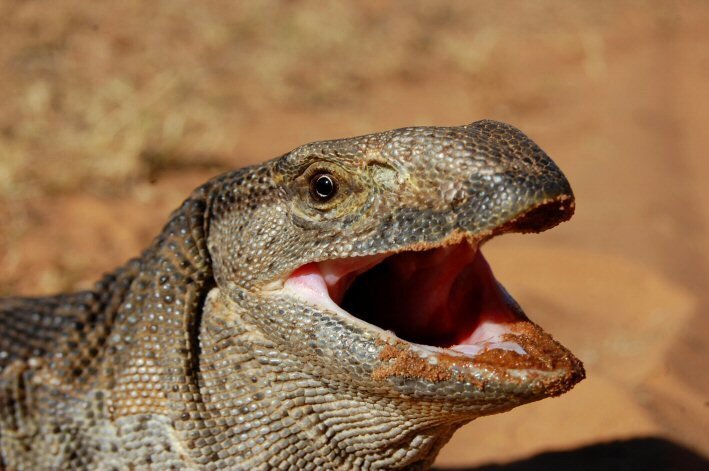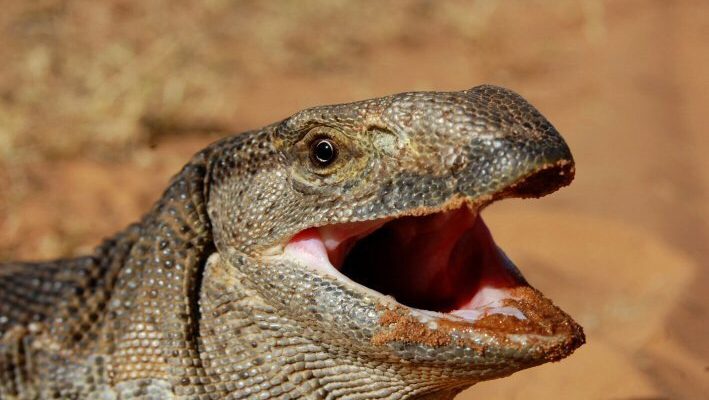
Exploring these similarities can be as fun as wandering through a wildlife park. Each creature has its quirks, and even though they may resemble the monitor lizard in one way or another, unique traits set them apart. Whether you’re an aspiring herpetologist or just a curious nature lover, this guide will help you understand these animals better, making your next outdoor encounter a little less daunting and a lot more interesting.
1. Iguanas
Iguanas are often mistaken for monitor lizards, and it’s easy to see why. They’re both large, visually striking reptiles often seen basking in the sun. However, iguanas are generally more robust and have a distinctively vibrant color, ranging from green to shades of blue and orange. One big giveaway is their dewlap—a flap of skin under their chin—used for communication and thermoregulation.
Another difference is their diet. While monitor lizards are carnivorous and enjoy a diet rich in insects and small animals, iguanas are primarily herbivores. They thrive on a diet of leafy greens and fruits, so if you ever see one munching on a salad instead of chasing down a bug, you’re likely looking at an iguana!
2. Komodo Dragons
If you’ve heard of monitor lizards, you’ve probably heard of Komodo dragons, the largest lizard species on Earth. At first glance, they might look like giant versions of their smaller cousins. Both Komodo dragons and monitor lizards have long, muscular bodies and an impressive array of sharp teeth.
But, here’s the thing: size matters. Komodo dragons can reach lengths of over 10 feet and weigh around 150 pounds, whereas most monitor lizards are much smaller. Their habitat also differs—Komodo dragons inhabit specific Indonesian islands, while monitor lizards have a broader range across Africa, Asia, and Australia.
3. Tegus
Tegus are another group of large lizards that can resemble monitor lizards in size and shape. These lizards are native to Central and South America and can even grow to a size that rivals some monitor lizards. A key difference is their appearance; tegus tend to have a bulkier body and more pronounced scales, giving them a different texture compared to the sleeker monitor lizard.
Diet-wise, tegus are omnivorous, feasting on plants, insects, and small mammals. If you spot a big lizard rummaging through the underbrush with a more robust physique, it’s likely a tegu rather than a monitor lizard.
4. Water Dragons
Water dragons are a staple in Australian wildlife and are another contender for the “monitor lizard lookalike” title. They are known for their long tails and relatively agile bodies, which help them navigate their aquatic habitats. Their color can vary widely, often displaying beautiful greens and browns, which allows them to blend into their surroundings.
The major distinction here is their preferred habitat. While monitor lizards can be found in numerous environments, water dragons are mostly aquatic, spending a lot of their time near rivers and ponds. Plus, water dragons have unique throat pouches that they use during territorial displays, setting them apart from monitor lizards.
5. Nile Crocodiles
While it may seem odd to include a crocodile in this mix, Nile crocodiles share some behavioral traits with monitor lizards. Both are predators, often lurking in the water before striking at prey. Their skin texture and coloration can also resemble that of a monitor lizard, especially when they’re basking on the riverbanks.
However, the differences are quite pronounced. Nile crocodiles are much larger, often growing over 16 feet in length, and they possess a more powerful bite. They also have a much more aggressive demeanor compared to the relatively docile monitor lizard. If you’re near the water and see a large creature lounging with that distinct snout, back away—there’s no mistaking a crocodile for a monitor!
6. Bearded Dragons
Bearded dragons are smaller lizards often kept as pets, and they can remind us of monitor lizards due to their unique appearance and charming personalities. They have a distinctive “beard” that can puff up when they feel threatened or are trying to impress another dragon, which is quite different from the more subdued look of a monitor lizard.
In terms of size, bearded dragons are much smaller, typically reaching about 2 feet in length. They also have a more rounded body shape and a friendly demeanor, making them popular among reptile enthusiasts. If you’re holding a lizard that seems sociable and has a beard, it’s probably not a monitor lizard!
7. Frilled Lizards
Frilled lizards are known for their dramatic frill of skin that they can expand when threatened. This can be quite a sight and is one way they defend themselves. Similar in body shape to monitor lizards, frilled lizards can often be spotted climbing trees in their native Australian forests.
You can tell them apart quickly by their frills and their unique tree-climbing abilities. While monitor lizards may also climb, nothing matches the frill’s dramatic flair! Their diet leans more towards insects and small vertebrates, like monitor lizards, but that frill is a surefire indication that it’s not a monitor lizard you’re looking at.
8. Blue-Tongued Skinks
Blue-tongued skinks can be a fun surprise because, unlike the slim monitors, these lizards have a more stout body and a notably shorter tail. Their most noticeable feature is their bright blue tongue, which they display as a warning to potential predators.
While they might have some similarities in habitat preferences, blue-tongued skinks are more terrestrial and prefer to hide in leaf litter or beneath rocks. Their diet consists primarily of plant matter, insects, and small creatures—quite different from the carnivorous diet of most monitor lizards. If you ever see a lizard with a vibrant blue tongue and a chunky body, you’re definitely not looking at a monitor lizard!
Exploring the world of reptiles can be captivating, especially when you see how different species interact, adapt, and thrive in their environments. From iguanas and tegus to the larger Komodo dragons and the striking blue-tongued skinks, each of these animals shares some characteristics with monitor lizards but also boasts unique traits that set them apart.
So, the next time you’re out and about or even just scrolling through your favorite wildlife shows, take a moment to appreciate the subtle differences among these fascinating creatures. Understanding their diversity only adds to the joy of experiencing nature. Who knows? You might just find yourself more intrigued than ever by the wonderful world of reptiles!

